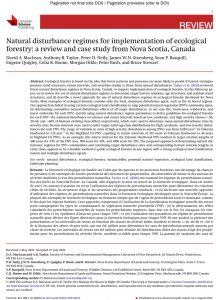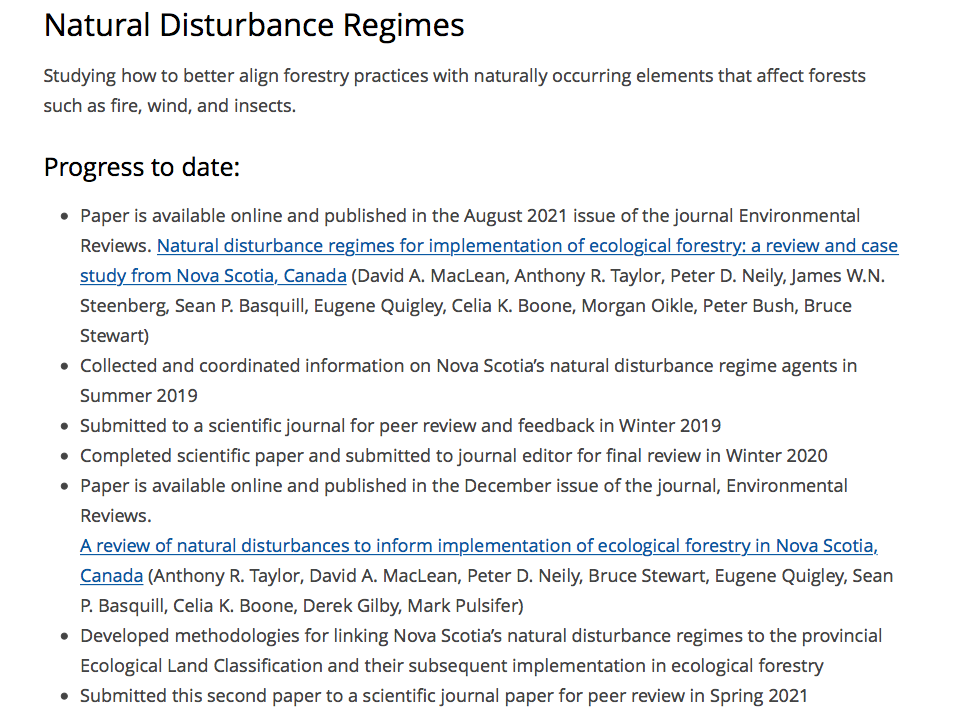
Front page of the 2nd Natural Disturbance Regimes paper with abstract. Click on image for larger, readable version. Access full paper here
This ‘Priority Project’ appears to be completed, pretty well on schedule, but many issues remain to be addressed at the landscape level. Surely it is time to adopt a key recommendation of Prof Lahey in his recent Evaluation of Progress, namely to “adopt a more centralized and directional approach to the organization of work on implementation of the FPR and assign overall leadership of the process to a forester who is committed to ecological forestry who has the experience and knowledge to lead Nova Scotia’s embrace of an ecological paradigm”.
I try to keep on top of what’s coming out from NRR in relation to the ‘Lahey Recommendations‘, and check the NS Government’s Ecological Forestry page fairly regularly.
On Feb 2, 2022, I checked the page for any announcement of the second published paper expected from the Natural Disturbance Regime Project. There were no updates about it.
So I wrote Naomi Arron, Senior Strategist, Nova Scotia Department of Lands and Forestry with whom I had correspondence with earlier about this project, and who had told me on Oct 13, 2020: “The department’s NDR project team is working towards submitting a scientific paper on the application of natural disturbance regimes to a journal for consideration and peer review in Spring 2021. Acceptance and the timing of publication will depend on the journal.” I asked her if there is any update on it.
I was quite surprised when she told me via e-mail today (Feb 4, 2022) in a response to my Feb 2 e-mail:
“The scientific paper on the application of natural disturbance regimes was peer-reviewed and published in Environmental Reviews in August 2021.
We have secured open access to the paper so that everyone can read it for free. You can now access the link to the article on our website: https://novascotia.ca/ecological-forestry/.
You can also access the paper directly here: https://cdnsciencepub.com/doi/full/10.1139/er-2021-0042
So there you go, it never occurred to anyone at NRR, apparently, to update the Natural Disturbance Regimes Project on the web page that is supposed to keep us all abreast of what’s going on, re Implementation of Ecological Forestry and the Communications Strategy.
It was obviously a quick update. Reads the Info now:
Logically, the paragraph announcing the second paper should go at the end of this chronology not at the beginning.
I haven’t read the paper in detail but can report that this second paper is comprehensive and holds together much better than the first paper (i.e., it is better written). And it clearly represents a significant change in DNR/L&F/NRR’s interpretation of Natural Disturbance Regimes in NS (view NSDNR’s nature-based forestry for comments on the previous version.)
There are a number of issues with the science that I and some other ecologists had with the first paper that have carried over to the second paper and that some of us tried to raise while the second paper was in preparation, but were firmly rebuffed – there were no valid “stakeholders” for this process in the view of L&F. But at least now, it’s all out there in detail and we – and others – have the option of raising such issues by having such concerns published in a peer reviewed paper or papers. (That’s generally a protracted process and is unlikely to happen anytime soon!)
I am concerned that some of the language still seems to give priority to forestry over protecting ecosystems and biodiversity contrary to the express directive of Bill Lahey e.g. this at the beginning of the Discussion:
Ecological forestry provides a comprehensive ecosystem-based framework for managing forests for human needs, while also maintaining forest health under a changing environment (Kuuluvainen et al. 2021). Ecological forestry aims to maintain substantial wood production while minimizing reductions in biodiversity, and includes both landscape-level and stand-level considerations.
Said Lahey:
“In other words, I have concluded that protecting ecosystems and biodiversity should not be balanced against other objectives and values as if they were of equal weight or importance to those other objectives or values. Instead, protecting and enhancing ecosystems should be the objective (the outcome) of how we balance environmental, social, and economic objectives and values in practising forestry in Nova Scotia.” – William Lahey, Aug 2018
There is no indication in this second paper, as there was in the first paper, that another paper can be expected, nor is there any info. on the Ecological Forestry page as to whether there are any further steps for this project. Is it officially completed now? I suspect it is.
As it stands, the second paper provides a database of sorts or reference for practicing Ecological Forestry in NS in a manner that simulates Natural Disturbance Regimes, and the Natural Disturbance Regimes project team were “key contributors” to the SGEM of 2021 (re: stand level forest management decisions).
There remain many uncertainties about NRR’s management of Crown land forests at the landscape level. There are many considerations in addition to the desire to emulate natural disturbance regimes that will or should influence exactly what practices are applied where, e.g.
– the need for old forest habitat and connectivity of old forest stands
– the need to address surface water acidification at the watershed level
– the new government’s commitment to 20% protection and agreements related to Indigenous Protected and Conserved Areas,
– the need to increase carbon sequestration
– how the area, number and placement of sites for High Production Forestry are determined
– whether the supply of wood from Crown lands will be maintained at traditional levels or substantially reduced
– implementation of the Mainland Moose Recovery Plan
Supposedly some of those components will be addressed in the to-date-elusive Environmental Assessment process which is to include “a guide for the preparation of 20- year forest stewardship plans”.
But there remain many loose ends.
L&F/NRR chose a slice of the Lahey Recommendations as “priority projects”. There seems to be a sense that once those are completed, that’s the end of it.
Prof. Lahey has underscored shortcomings of that assumption, and they are revealed in practice by concerns about AP068499 Beals Meadow where a “Natural Resources official says pending cut adheres to Lahey Report recommendations” – the concerns that have been expressed about harvesting that site are mainly landscape level concerns.
Addressing these multiple and interacting issues is understandably a very challenging task, more so for a department with “a dispersed organizational structure that is composed of numerous invested stakeholders” (cited in the Communications Strategy).
Surely, it is time for government to adopt a key recommendation of Prof Lahey in his recent Evaluation of Progress:
The Department needs to adopt a more centralized and directional approach to the organization of work on implementation of the FPR and assign overall leadership of the process to a forester who is committed to ecological forestry who has the experience and knowledge to lead Nova Scotia’s embrace of an ecological paradigm. Appointment of this person to the vacant statutory position of the province’s Chief Forester should be considered.
In the meantime, a belated congratulations to the authors/Project Team for completing the two peer-reviewed papers on Natural Disturbance Regimes, pretty well on schedule.
Some Related Posts, Pages etc
On logging of Crown land parcel AP068499 Beals Meadow, Nova Scotia: 2. Highgrading at the Landscape Level 27Jan2022
Post on NSFN Jan 27, 2022
An assessment of Nova Scotia L&F’s progress in implementing Ecological Forestry in response to the Lahey Report, Part 3: The Project Muddle 8Sep2020
Post on NSFN Sep 8, 2020
Consultations
A new section on the website as of Dec 9, 2021 to help keep track of post-Lahey Report Consultations
The Nova Scotia Forest “Disturbance Paper” is out, also a paper on Borealization of the Acadian forest 31Aug2020
Post on NSFN Aug 31, 2020
Biodiversity Landscape Planning for Nova Scotia is being developed as part of the L&F Environmental Assessment Project 16Jun2020
Post on NSFN Jun 16, 2020
Draft Nova Scotia Forestry EA Process surfaces 21May2021
Post on NSFN May 21, 2021
Strategy for Improving Openness, Transparency, Collaboration and Accountability at the Department of Lands and Forestry
Communications and Engagement Strategy, prepared by DG Communications for the Department of Lands and 1 Forestry June 20, 2019
This Stakeholder Engagement and Communications Plan (“the Plan”) provides recommendations for the Department to enhance its two-way communication with stakeholders, help build trust in decisions, identify opportunities for stakeholder engagement and collaboration and provide a framework for accountability around decision-making and work happening within the Department.
Note about Edits of Posts on NSFN
I often make substantial revisions of a post within in the first 24 hours after I post it, as I did in this case. (It was posted circa 8 pm Feb 4, substantive revisions were made and completed 12 hours later.) After that, any changes are primarily small edits, if not I make them as a formal “UPDATE”.

